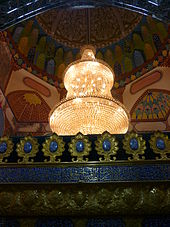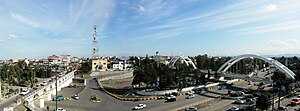Amol
| Amol | ||
|---|---|---|
| Left 17th century Davazdah-Tscheschme Bridge, right modern Moalagh Bridge over the Haraz River | ||
|
|
||
| Basic data | ||
| Country: |
|
|
| Province : | Māzandarān | |
| Coordinates : | 36 ° 28 ′ N , 52 ° 21 ′ E | |
| Height : | 76 m | |
| Surface: | 21 km² | |
| Residents : | 199,698 (2000) | |
| Population density: | 10 inhabitants per km² | |
| Postal code : | 46131-46391 | |
| Time zone : | UTC +3: 30 | |
Amol ( pronunciation : [ ɒmol ], Persian آمل Āmol ) is a city in northern Iran in the province of Māzandarān . The city is located 20 km south of the Caspian Sea and 10 km north of the Elburs Mountains .
history
According to archaeological finds, the city and its surroundings were already inhabited 29,000 years ago. Some historians bring the city u. a. associated with the Pishdadians (Pīschdādiyān) and the Kayanids . Coin finds suggest that Āmol u. a. was the capital of the region and the country during the Sassanid era . The city was under the Abbasids - Caliphate Islamized . After the destruction by the Mongols , Sari became the capital of Mazandaran. After that, the capital switched between the two cities a few times. The current city of Āmol lies north of the old city complex.
trade
The city is a trading center for oranges , rice , iron and coal .
Attractions
Natural sights
- Damawand , with 5610 m the highest mountain in the Near and Middle East
- Lar Park and Dam, Larijan
- Haraz River with a river that is worth seeing
- Haraz Forest Park on the route between Tehran and Āmol
- Ab-Esk hot springs used to treat skin conditions
- Larijan hot springs for the treatment of skin diseases
- Amolu spring - the water is suitable for the treatment of intestinal diseases
- Alomol waterfall , reaches more than 100 m high with beautiful spray
- Yachi waterfall, completely frozen waterfall at an altitude of 5100m
- Shahandash waterfall
- Deryuk waterfall
- Tala Park (Golden Park)
- Alimastan Forest, Ziaro and Blairan
- 8th century Qasim shrine
- Shekl Shah inscription
- Malek Bahman (Bahman Castle), 1st century
- Sasanian bazaar from the 2nd century
Historical sights
- Friday mosque ( masdschid dschāmiʿ ) with basic structures from the 8th century
- Mashhad Mirbozorg mausoleum from the 8th century
- Heydar Mir Amoli Shrine, 8th century
- Imamzadeh Ebrahim, burial place, 9th century
- Imamzadeh Abdollah tomb
- Sasanian fire temple
- Imam Hassan Askari Mosque
- Aschraf bath, 8th century, oldest bath in Āmol
- Shah Abbas bath
- Naser al Haqq funeral tower
- Gole-Zard and Kafar-Keli Caves, Larijan
- Davasdah Pelleh Bridge (twelve-step bridge), 120 m long architecturally protruding bridge from the 18th century
- Moalagh Bridge
- historical Museum
- Agha Abbas mosque
- Mirza Kochakkhan Mosque
sons and daughters of the town

- Fereydūn is a figure in Persian mythology. He is the sixth mythical primeval king and is described in the sixth book of Shāhnāme , the Persian book of kings by the Persian poet Firdausi (940 / 41-1020).
- Ali ibn Sahl Rabban al-Tabari , Abu al-Hasan Ali ibn Sahl Rabban al-Tabari Amoli (c. 838 - c. 870) was a Persian doctor and scholar (Hakim) who wrote the first medical encyclopedia. His famous student Abu Bakr Mohammad Ibn Zakariya al-Razi has tarnished his fame. Ali came from an important Jewish family. His father Saul ben Bischr was an astronomer and astrologer from Merw in Tabaristan (hence al-Tabari - the Tabaristani). Ali converted to Islam in the service of the Abbassid caliph Al-Mutasim (833 - 842), who appointed him to his court. His successor Al-Mutawakkil (847-861) also kept him in his service. Ali ibn Sahl mastered Syriac and Greek, the two sources of ancient medical tradition lost to medieval Europe, and wrote verse in beautiful calligraphy.
- Tabari , historian and scholar. Abû Ja'far Muhammad Ibn Jarīr Ibn Yazīd at-Tabarī, Arabic أبو جعفر محمد بن جرير بن يزيد الطبري, DMG Abū Ǧaʿfar Muḥammad b.Ǧarīr b.Yazīd aṭ-Ṭabarī , called at-Tabarī (* 839 in Amol, Tabaristan , † January 19, 923 in Baghdad ), was an important Islamic historian and scholar of Persian descent. Little data is available about his life.
- Abu Sahl al-Quhi , Abu Sahl Waidschan ibn Rustam al-Quhi, also al-Kuhi (Arabic أبو سهل ويجن بن رستم القوهي, DMG Abū Sahl Waiǧan b.Rustam al-Qūhū, Persian ابوسهūهی Sahlhī, Persian ابوسهūهی Sahlhī ابوس هل بیژن ; * around 940 from Quh in Tabaristan, Iran; † around 1000) was a Persian astronomer and mathematician.
- Sahl ibn Bischr (al-Israili) was a Jewish astrologer, astronomer and mathematician from Tabaristan. He was the father of the famous scientist and doctor Ali ibn Sahl Rabban al-Tabari (Ali bin Radha al-Tabari), who converted to Islam.
- Fachr ad-Dīn ar-Rāzī , Abu Abdullah Muhammad ibn Umar ibn al-Husayn at-Taymi al-Bakri at-Tabaristani Fachr ad-Din ar-Razi [1] (persisc أبو عبد الله محمد بلد الله الاابا بن عمر الساد لسن فخرد بن الن , DMG Abū ʿAbd Allāh Muḥammad b. ʿUmar b.al-Ḥusain Faḫr ad-Dīn ar-Rāzī; * 1149 in Ray, Iran; † 1209 in Herat, now Afghanistan) was an eminent Persian Sunni theologian and philosopher who also learned about medicine , Wrote physics, astrology, literature, history and law.
- Muhammad ibn Mahmud al-Amuli , Muhammad ibn Mahmud al-Amuli (1300-1352) was a Persian doctor from Māzandarān . He penned a commentary on Avicenna's writings and created a comprehensive encyclopedia between 1335 and 1342 entitled Nafa'is al-funun fi 'ara'is al-'uyun (Treasures of Science).
- Sayyed Zahiruddin Mar'ashi (* 1413 in Amol; † 1488) was an Iranian scholar and historian. He comes directly from the ruling family of the Mar'ashi. His grandfather, Sayyed Kamaluddin Mar'ashi, ruled the city of Sari and participated in the military resistance against Tamerlan's attack on Persia. Mir Sayyed Zahiruddin Mar'ashi's father, Sayyed Nasiruddin Mar'ashi, lived as a confidante of his own older brother Ali at his court in Sari. The tomb of his ancestor Mir Ghawamuddin Mar'ashi in the city of Amol is called "Mir Bozorg" ("Great Prince").
- Tāleb-e Āmoli, Persian poet of the 16th and early 17th centuries at the court of Jahangir , wrote the Jahangir-nāmeh
- Abbas Mirza , Abbas Mirza (* 1783 Amol † October 25, 1833 in Mashhad) was a Persian prince and the second son of the Shah of Persia, Fath Ali. He had appointed him heir to the throne and thereby passed over the legal succession of his older brother, Mohammed Ali Mirza. Mohammed Ali's mother was from Georgia and was not of the Qajar tribe. Because of this, he was excluded from the line of succession.
- Ali Larijani , Ali Ardeschir Larijani, also Ali Laridjani or Ali Larijani (* 1958 in Nadschaf im Amol) is an Iranian politician. Larijani is considered a follower of Chāmene'īs, is secretary of the National Security Council, which is also responsible for nuclear issues, and since May 26, 2008, due to the power shift in the Iranian parliamentary elections in 2008, speaker of parliament and parliamentary president and was considered a potential candidate for the presidency of Iran [ 1].
- Sadegh Larijani , Sadegh Larijani (* 1960 in Najaf, Iraq) is a Shiite clergyman with the title Hodschatoleslam, member of the Guardian Council since 2001 and has been the new head of the judiciary of Iran since August 15, 2009. He is the successor to Mahmud Hashemi Shahrudi , whose term of office was not extended by the revolutionary leader Ayatollah Ali Khamene'i.
- Ghasem Rezaei (born August 18, 1985 in Amol) is an Iranian wrestler.
- Seyyed Heydar Amoli is a philosopher.
photos
See also
literature
- CAIS (Circle of Ancient Iranian Studies): 29000 Years of Human Settlements in Mazandaran , July 27, 2006
Web links
- Amol . In: Ehsan Yarshater (Ed.): Encyclopædia Iranica (English, including references)
- Website of the Cultural Heritage News Agency (CHN-Press) on the province of Mazandaran with information on Āmol ( Memento from June 18, 2009 in the Internet Archive ) (English)








